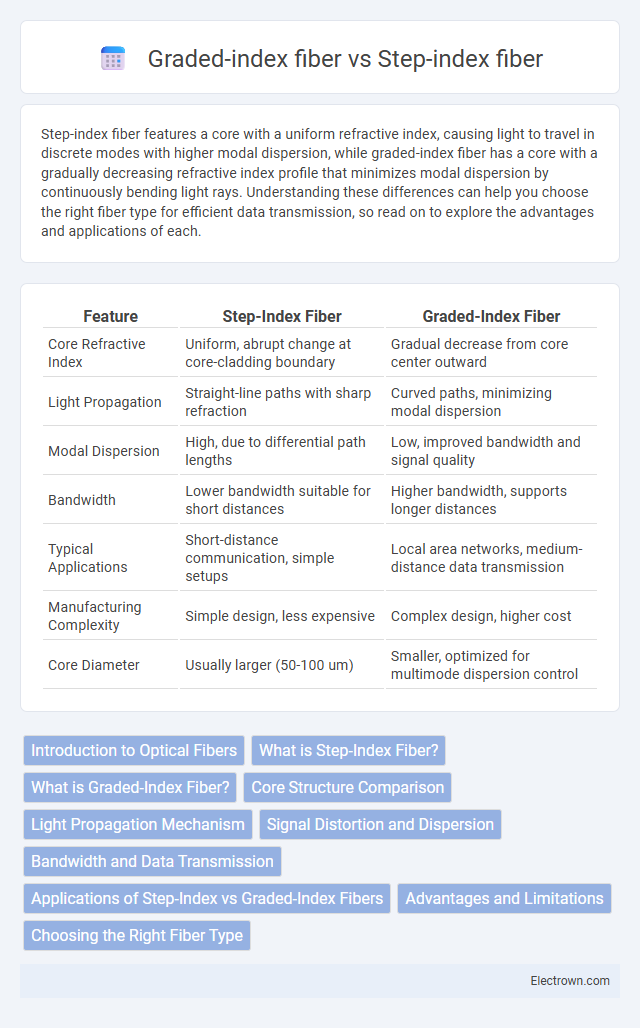Step-index fiber features a core with a uniform refractive index, causing light to travel in discrete modes with higher modal dispersion, while graded-index fiber has a core with a gradually decreasing refractive index profile that minimizes modal dispersion by continuously bending light rays. Understanding these differences can help you choose the right fiber type for efficient data transmission, so read on to explore the advantages and applications of each.
Table of Comparison
| Feature | Step-Index Fiber | Graded-Index Fiber |
|---|---|---|
| Core Refractive Index | Uniform, abrupt change at core-cladding boundary | Gradual decrease from core center outward |
| Light Propagation | Straight-line paths with sharp refraction | Curved paths, minimizing modal dispersion |
| Modal Dispersion | High, due to differential path lengths | Low, improved bandwidth and signal quality |
| Bandwidth | Lower bandwidth suitable for short distances | Higher bandwidth, supports longer distances |
| Typical Applications | Short-distance communication, simple setups | Local area networks, medium-distance data transmission |
| Manufacturing Complexity | Simple design, less expensive | Complex design, higher cost |
| Core Diameter | Usually larger (50-100 um) | Smaller, optimized for multimode dispersion control |
Introduction to Optical Fibers
Optical fibers transmit light through a core surrounded by cladding, enabling high-speed data communication. Step-index fibers have a uniform core refractive index, causing light to travel in a straight path with higher modal dispersion. Graded-index fibers feature a varying refractive index in the core, reducing modal dispersion and improving bandwidth for longer-distance communication.
What is Step-Index Fiber?
Step-index fiber features a core with a uniform refractive index surrounded by a cladding layer with a lower refractive index, enabling total internal reflection for light propagation. This fiber type supports multimode or single-mode transmission, but multimode step-index fibers often exhibit higher modal dispersion, limiting bandwidth over long distances. Step-index fibers are typically used in short-distance communication and sensor applications due to their simpler design and lower manufacturing cost.
What is Graded-Index Fiber?
Graded-index fiber features a core with a refractive index that gradually decreases from the center outward, minimizing modal dispersion and allowing for higher bandwidth over longer distances compared to step-index fiber. This design enables light rays to travel at different speeds but reach the end simultaneously, improving signal quality and reducing distortion. Your network performance benefits from the enhanced data transmission capabilities offered by graded-index fibers in multimedia and high-speed communication applications.
Core Structure Comparison
Step-index fiber features a uniform core refractive index with a sharp boundary between the core and cladding, enabling light to propagate in a straight path. Graded-index fiber has a core with a gradually decreasing refractive index from the center outward, which reduces modal dispersion by bending light rays smoothly. Your choice between these fibers impacts signal quality and bandwidth, as graded-index fibers typically offer better performance for high-speed data transmission.
Light Propagation Mechanism
Step-index fiber guides light through a core with a uniform refractive index, causing total internal reflection at the interface with the cladding, resulting in discrete light paths or modes. Graded-index fiber features a core with a refractive index that gradually decreases from the center outward, reducing modal dispersion by bending light rays smoothly and enabling faster signal transmission. This gradient in refractive index minimizes pulse broadening and enhances overall bandwidth performance compared to step-index fibers.
Signal Distortion and Dispersion
Step-index fiber experiences higher modal dispersion due to abrupt changes in refractive index, causing significant signal distortion over long distances. Graded-index fiber minimizes modal dispersion by gradually varying the refractive index profile, allowing different light modes to converge at the receiver with reduced distortion. This results in improved bandwidth and signal quality, making graded-index fibers more suitable for high-speed data transmission.
Bandwidth and Data Transmission
Step-index fiber features a sharp refractive index contrast between the core and cladding, resulting in modal dispersion that limits bandwidth and reduces data transmission distance. Graded-index fiber gradually decreases the refractive index from the core center outward, minimizing modal dispersion and enabling higher bandwidth with improved data transmission over longer distances. Consequently, graded-index fibers are favored for high-speed, long-distance communication networks due to their superior performance in maintaining signal integrity.
Applications of Step-Index vs Graded-Index Fibers
Step-index fibers are commonly used in short-distance data communication and optical sensor applications due to their simple design and cost-effectiveness. Graded-index fibers are preferred for high-speed, long-distance data transmission in telecommunications and local area networks because they minimize modal dispersion and maintain signal integrity. Your choice between these fibers depends on the required bandwidth, distance, and application complexity.
Advantages and Limitations
Step-index fiber offers simplicity and cost-effectiveness with a sharp refractive index boundary, making it ideal for short-distance communication, but it suffers from higher modal dispersion causing signal distortion over longer distances. Graded-index fiber reduces modal dispersion through a gradual refractive index change, enhancing bandwidth and supporting higher data rates over longer spans, although it is more expensive and complex to manufacture. Choosing the right fiber affects your network's performance, balancing installation costs against transmission quality and distance requirements.
Choosing the Right Fiber Type
Step-index fiber features a uniform core refractive index with a sharp boundary between core and cladding, offering simpler manufacturing and cost efficiency ideal for short-distance data transmission. Graded-index fiber gradually changes the core refractive index, reducing modal dispersion and improving bandwidth, making it better suited for longer-distance and high-speed communication. Your choice depends on balancing distance, bandwidth requirements, and budget constraints to ensure optimal network performance.
Step-index fiber vs Graded-index fiber Infographic

 electrown.com
electrown.com